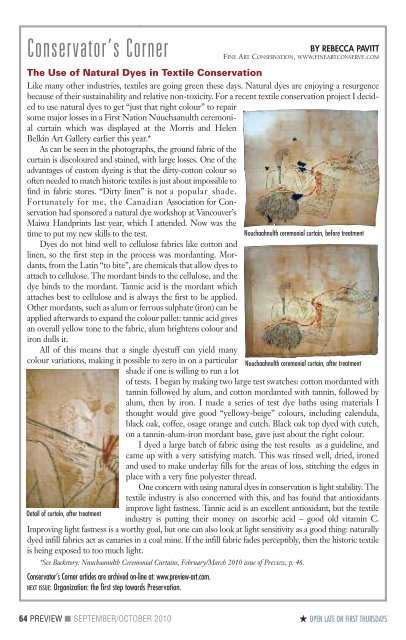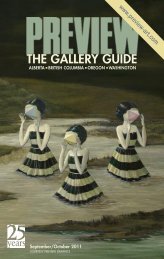Sept-October 2010 - Preview
Sept-October 2010 - Preview
Sept-October 2010 - Preview
You also want an ePaper? Increase the reach of your titles
YUMPU automatically turns print PDFs into web optimized ePapers that Google loves.
Conservator’s CornerBY REBECCA PAVITTFINE ART CONSERVATION, WWW.FINEARTCONSERVE.COMThe Use of Natural Dyes in Textile ConservationLike many other industries, textiles are going green these days. Natural dyes are enjoying a resurgencebecause of their sustainability and relative non-toxicity. For a recent textile conservation project I decidedto use natural dyes to get “just that right colour” to repairsome major losses in a First Nation Nuuchaanulth ceremonialcurtain which was displayed at the Morris and HelenBelkin Art Gallery earlier this year.*As can be seen in the photographs, the ground fabric of thecurtain is discoloured and stained, with large losses. One of theadvantages of custom dyeing is that the dirty-cotton colour sooften needed to match historic textiles is just about impossible tofind in fabric stores. “Dirty linen” is not a popular shade.Fortunately for me, the Canadian Association for Conservationhad sponsored a natural dye workshop at Vancouver’sMaiwa Handprints last year, which I attended. Now was thetime to put my new skills to the test.Dyes do not bind well to cellulose fabrics like cotton andlinen, so the first step in the process was mordanting. Mordants,from the Latin “to bite”, are chemicals that allow dyes toattach to cellulose. The mordant binds to the cellulose, and thedye binds to the mordant. Tannic acid is the mordant whichattaches best to cellulose and is always the first to be applied.Other mordants, such as alum or ferrous sulphate (iron) can beapplied afterwards to expand the colour pallet: tannic acid givesan overall yellow tone to the fabric, alum brightens colour andiron dulls it.All of this means that a single dyestuff can yield manycolour variations, making it possible to zero in on a particularshade if one is willing to run a lotDetail of curtain, after treatmentNuuchaahnulth ceremonial curtain, before treatmentNuuchaahnulth ceremonial curtain, after treatmentof tests. I began by making two large test swatches: cotton mordanted withtannin followed by alum, and cotton mordanted with tannin, followed byalum, then by iron. I made a series of test dye baths using materials Ithought would give good “yellowy-beige” colours, including calendula,black oak, coffee, osage orange and cutch. Black oak top dyed with cutch,on a tannin-alum-iron mordant base, gave just about the right colour.I dyed a large batch of fabric using the test results as a guideline, andcame up with a very satisfying match. This was rinsed well, dried, ironedand used to make underlay fills for the areas of loss, stitching the edges inplace with a very fine polyester thread.One concern with using natural dyes in conservation is light stability. Thetextile industry is also concerned with this, and has found that antioxidantsimprove light fastness. Tannic acid is an excellent antioxidant, but the textileindustry is putting their money on ascorbic acid – good old vitamin C.Improving light fastness is a worthy goal, but one can also look at light sensitivity as a good thing: naturallydyed infill fabrics act as canaries in a coal mine. If the infill fabric fades perceptibly, then the historic textileis being exposed to too much light.*See Backstory: Nuuchaanulth Ceremonial Curtains, February/March <strong>2010</strong> issue of <strong>Preview</strong>, p. 46.Conservator’s Corner articles are archived on-line at: www.preview-art.com.NEXT ISSUE: Organization: the first step towards Preservation.64 PREVIEW ■ SEPTEMBER/OCTOBER <strong>2010</strong> ★ OPEN LATE ON FIRST THURSDAYS

















